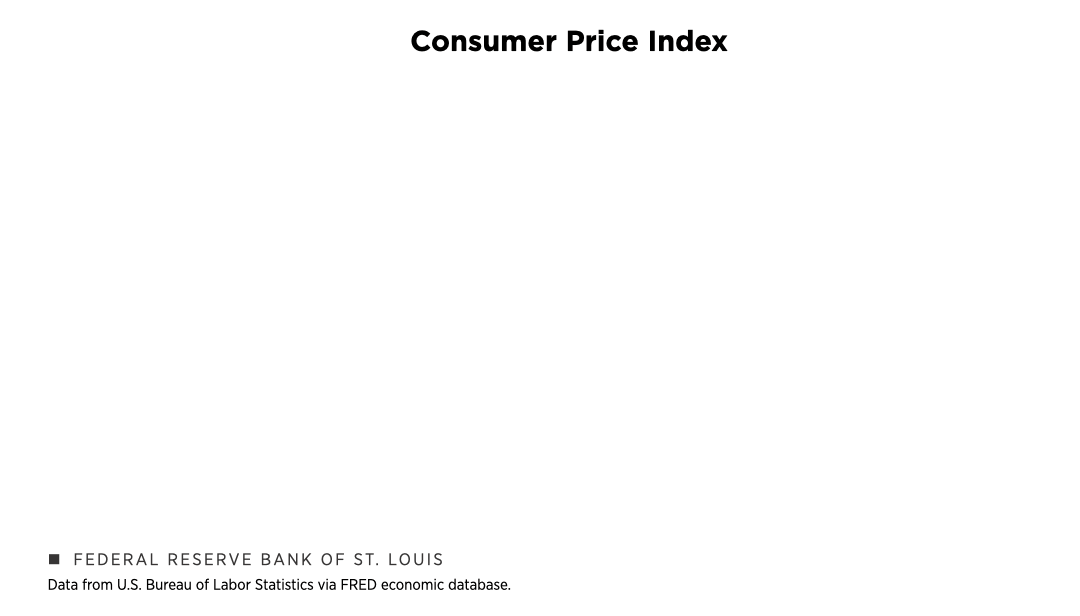Inflation, Disinflation and Deflation: What Do They All Mean?
You have likely heard about rising prices or inflation in the news or daily conversation. But what about “disinflation” or “deflation”? Those lesser-known terms describe different aspects of changes in prices.
Let’s start with base definitions.
- Inflation is a sustained increase in the price level of goods and services.
- Disinflation is a decrease in the rate of inflation.
- Deflation is a sustained decrease in the price level of goods and services.
Inflation, disinflation and deflation refer to increasing or decreasing average price levels of the economy. They usually are calculated as the percentage change in a given price level over a certain period of time—for example, the percentage change from a year earlier. While some prices may deviate from the overall trend, we focus on the aggregate trend for the purposes of this blog post. (See this February 2023 On the Economy blog post for more information on relative prices.)
Examples of Inflation, Disinflation and Deflation
Let’s visually break down the difference between inflation, disinflation and deflation with an example. Below we graph the year-over-year percentage change in the CPI from April 2008 to October 2009 in the U.S., during the Great Recession and the first few months of recovery. As the animation below shows, inflation is an increase in the price of goods and services, shown from April to November 2008. Inflation declines from July to November 2008—that is, there is disinflation: Prices are still increasing, but more slowly than before. Deflation, seen from March 2009 to October 2009, is a sustained decrease in the price of goods and services.

Let’s take an example basket of goods in Year 1. (See the table below.) At the start of our sample, in Year 1, the inflation rate is 4%. At the end of that year, the price level is $10.
During Year 2, the rate of price change could do one of three things:
- Rise to 5% (inflation)
- Decline to 3% (disinflation)
- Decrease to a negative 1% (deflation)
Notice that in the inflation and disinflation scenarios, the prices increase, and the inflation rates are positive. In the disinflation scenario, the price increases less than it would under the higher inflation scenario, but nonetheless, it still increases. Conversely, in the deflation scenario, the price of the product decreases, and the inflation rate is negative.
| Inflation | Disinflation | Deflation | |
|---|---|---|---|
| January Year 1 | 4% $10 |
||
| January Year 2 inflation rate and price changes | 5% $10.50 |
3% $10.30 |
-1% $9.90 |
The Causes of (Dis)Inflation and Deflation
Lots of forces—e.g., fiscal policy or supply shocks—can cause relatively brief changes in supply and demand that drive fluctuations in the price level that can last from a few months to a few years. For example, a large hike in oil prices can put upward pressure on prices that generates some temporary inflation.
Conversely, sustained inflation is generally considered to come from “too much money chasing too few goods.” In practice, this implies that monetary policy is the most direct tool for influencing inflation. While other factors, such as commodity price shocks or productivity changes, can modestly affect inflation, central banks should be able to offset the long-term trends created by such factors. So, for example, if productivity growth slows from 1% a year to 0.5% a year, this would tend to raise the inflation rate by about 0.5% a year, all else equal. But the central bank could offset that increase through slightly tighter monetary policy.
The Effects of Disinflation and Deflation
Now that we know the difference between disinflation and deflation, let’s look at how their effects differ. Prolonged disinflation can be quite painful, as it is usually accompanied by a recession, as it was in the early 1980s when the Federal Reserve reduced monthly year-over-year inflation from 14.6% in March 1980 to 2.4% in July 1983. Over a similar period, the unemployment rate rose by about 4.5 percentage points before falling back.The unemployment rate rose from 6.3% in March 1980 to 10.8% in November 1982 before declining again to 9.4% in July 1983.
Although the process of disinflation can be painful, the outcome of a disinflationary period is generally good for the economy. High inflation can disproportionately affect low- and fixed-income households, so disinflation can reduce those effects, according to a January 2023 article by Federal Reserve Bank of Dallas researchers. For example, low-income households tend to spend more of their income on essential goods, so they may be unable to reduce their spending when prices increase—causing financial strain.
Many economists contend that deflation is harmful to the economy, although this claim is disputed.
One argument for why deflation is harmful is that it puts a floor under the real (or inflation-adjusted) interest rate—that is, the real interest rate is higher than the nominal interest rate in a deflationary environment. In turn, this might lead to too much saving and not enough investment, resulting in underutilized resources and unemployment.
It may seem counterintuitive to say that decreasing prices are bad—who wouldn’t want to pay less for goods? But another theory, which has its skeptics, suggests that when the overall economy experiences decreasing prices, people might wait to buy things. They expect their purchasing power (how many things they can buy with the same amount of money) to be greater in the future than it is now in a deflationary environment. In other words, if they expect prices to be lower tomorrow than today, they might wait until tomorrow (or sometime in the future) to buy—and inadvertently help fuel a deflationary loop. (See illustration.)

The State of Inflation Today
The below chart from economic database FRED plots the year-over-year percentage change in the CPI. As this chart shows, the last time the United States experienced average price decreases was in 2009, around the Great Recession. That period of deflation was short and mild.
More recently, the U.S. economy suffered from high inflation rates after the COVID-19 pandemic. CPI inflation peaked at nearly 9% in June 2022. As of the date of this blog post, the economy has generally been in a period of disinflation, during which prices are still increasing, but more slowly than in the previous months, according to this measure.

Note
- The unemployment rate rose from 6.3% in March 1980 to 10.8% in November 1982 before declining again to 9.4% in July 1983.
This blog explains everyday economics and the Fed, while also spotlighting St. Louis Fed people and programs. Views expressed are not necessarily those of the St. Louis Fed or Federal Reserve System.
Email Us


